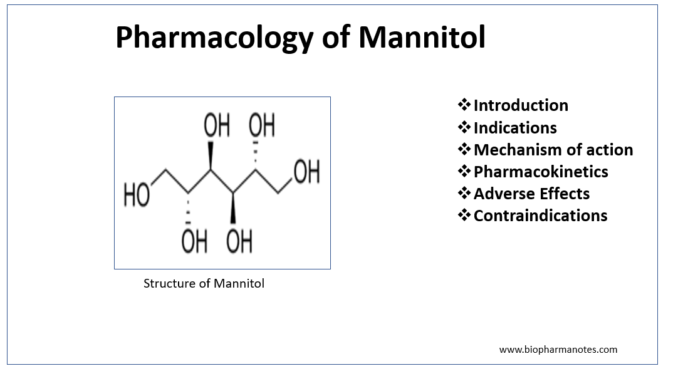
- Mannitol is low molecular weight non-electrolyte and is used as osmotic diuretic. It is a sugar (polyhydroxy aliphatic alcohol) and occurs naturally in fruits and vegetables. It is included in World Health Organization’s List of Essential Medicines.
- Diuretics are the drugs which increases urine formation along with natriuresis. Diuretics can be classified into different types. Some of them includes osmotic diuretics, loop diuretics, carbonic anhydrase inhibitors and thiazide related compounds.
- Osmotic diuretics are small molecular weight substances with following properties:
- Pharmacologically inert
- Generally non-metabolizable
- Freely filtered at glomerulus
- Not reabsorbed by renal tubules.
Indications of mannitol
- Used in treating patients with increased intracranial pressure or acute renal failure due to shock, trauma and drug toxicities.
- It is used in barbiturate poisoning.
- To reduce intraocular pressure (IOP) in glaucoma and for short term reduction of IOP during ocular surgery.
- To reduce cerebral edema before and after neurosurgery.
- Used to maintain osmolarity of ECF during rapid dialysis.
- It is recently approved by FDA (in 2020) as add on maintenance therapy for controlling pulmonary symptoms associated with cystic fibrosis in adult patients
Mechanism of action of mannitol
- It mainly acts in proximal convoluted tubule and the descending limb of the loop of Henle (sites which are freely permeable to water).
- As it is nonabsorbable, it exerts osmotic effect. It expands ECF (extracellular fluid), increases the renal blood flow resulting in reduction of the medullary tonicity which causes inhibition of water extraction from descending loop. This limits passive reabsorption of sodium from the thick ascending limb of loop. Hence, it increases osmolality of glomerular filtrate, facilitate excretion of water and inhibit reabsorption of sodium, chloride and other solutes.
- It prevents concentration of toxic substances in tubular fluid and enhances urinary excretion of toxic materials.
Pharmacokinetics of mannitol
- It is administered through IV route. Mannitol should be administered in large doses to be effective. It is not metabolized and is excreted unchanged in urine.
- It is rapidly filtered by glomeruli and cause osmotic diuresis. Its half life is 0.5- 1.5 hours.
Adverse effects
- Common side effects include headache, nausea and vomiting. These occur due to hyponatremia caused by extraction of water. It can also cause cellular dehydration.
- It can cause pulmonary edema in patients with CHF (Congestive Heart Failure) and hyponatremia. hypersensitivity reactions are rare. When used for prolonged period, it can cross BBB (Blood Brain Barrier), enter brain parenchyma and may increase intracranial pressure.
Contraindication
Contraindicated in:
- patients with pulmonary congestion and edema.
- CHF patients.
- In intracranial bleeding except during craniotomy.
- Established acute renal failure with anuria.
- In metabolic edema with abnormal capillary fragility.
- It should be used with caution in pregnancy and high doses should be avoided.
References
- https://go.drugbank.com/drugs/DB00742
- Essentials of Neuroanesthesia and Neurointensive Care. 2008: 311-314.
- Pharmacology and Pharmacotherapeutics. 24th edition.
- Goodman and Gillman Manual of Pharmacology and Therapeutics.
- Lippincott Illustrated Reviews Pharmacology, 6th edition.
- Essentials of Medical Pharmacology. 7th edition.